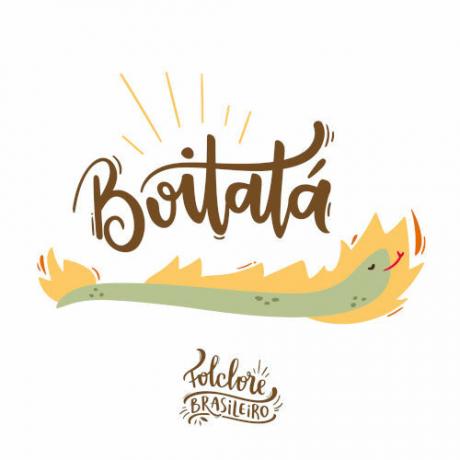O Boitata is a legend of Brazilian folklore that it speaks of a fire snake with many eyes and that protects the fields, especially from those who try to set fire to these places. The first record of the legend of boitatá was made by José de Anchieta, in the 16th century. This legend varies a lot according to the region of Brazil.
Accessalso: What do you know about the dry-body legend?
Knowing the boitatá
The boitatá is a being of Brazilian folklore traditionally identified as a fire snake, whose purpose is to protect the fields of those who promote arson. In folklore, the boitatá is shaped like a fire snake with many eyes, from which flames also come out.

In the legend, the boitatá can also turn into a burning log to kill the men who destroy the lawns. Regardless of the form, the boitatá kill the men who damage the fields. Legend has it that he has many eyes because ate the pupils of many animals - which also justifies the luminosity of this being.
Do not stop now... There's more after the advertising ;)
Origin of legend
O first record that you have of boitatá is from May 31, 1560, in an account written by the priest JesuitJosé de Anchieta. In his mention, José de Anchieta spoke of a ghost that the Indians called Baetata, defining it as a “sparkling beam” that killed them, just as it was the nature of curupiras.
In the translation given by José de Anchieta, Baetata it means "fire thing", a word formed from the junction of two Tupi words: mbai, which means "thing", and tata, which means “fire”. The description of the boitatá and its legend serve as explanation for the wildfire, a small flame that spontaneously arises from the decomposition of organic matter.

Also, the anthropologist Luís da Câmara Cascudo explains that the movement of the willow fire caused it to be assimilated to the movement of a snake|1|. Coincidentally, the word for “snake” in Tupi is very similar to the word that defines “thing”. As we saw, thing is mbai and snake is mob, therefore, this monster turned into mox tata or, simply, boitatá.
The legend spread throughout Brazil, and its popularization made the mob-tata turned into boitatá, because the pronunciation of the word mob in Tupi it is similar to the word “boi” in the Portuguese language.
Accessalso: Pink dolphin, one of the most traditional folklore legends in Northern Brazil
Legend Variations
The most common form by which the boitatá is known is the fire snake, but the popularization of the legend in Brazil and its spread to other regions made the character win distinct characteristics according to the placeof the country you are in.
Among the different views of the boitatá are: the Indians believed that he would kill them; in some regions of Brazil, as in Rio Grande do Sul, it was said that the boitatá killed and ate the animals that crossed its path; in other places, like Santa Catarina, he is actually a bull with a gigantic eye on his forehead.
There are places in Brazil that understand the boitatá as the manifestation of the spirits of people who were not baptized. This description is understood as a influenceEuropean in legend, for, on that continent, many understood the willow fire as the lost soul of the unbaptized. However, the most traditionally conceived form of this being from our folklore is, in fact, as the protector of natural lawns.
In addition to these variations in characteristics, the name of the boitatá can change depending on the region of the country. In some places of the North East and North, he is known as Blate, already in the regions more to the South of Brazil, this being is called by names like Boitata, Batata and Baitata.
Note
|1| CAMERA CASCUDO, Luís da. Geography of Brazilian Myths. São Paulo: Global, 2012.
By Daniel Neves
History teacher
Would you like to reference this text in a school or academic work? Look:
SILVA, Daniel Neves. "Boitatá"; Brazil School. Available in: https://brasilescola.uol.com.br/folclore/boitata.htm. Accessed on June 27, 2021.


